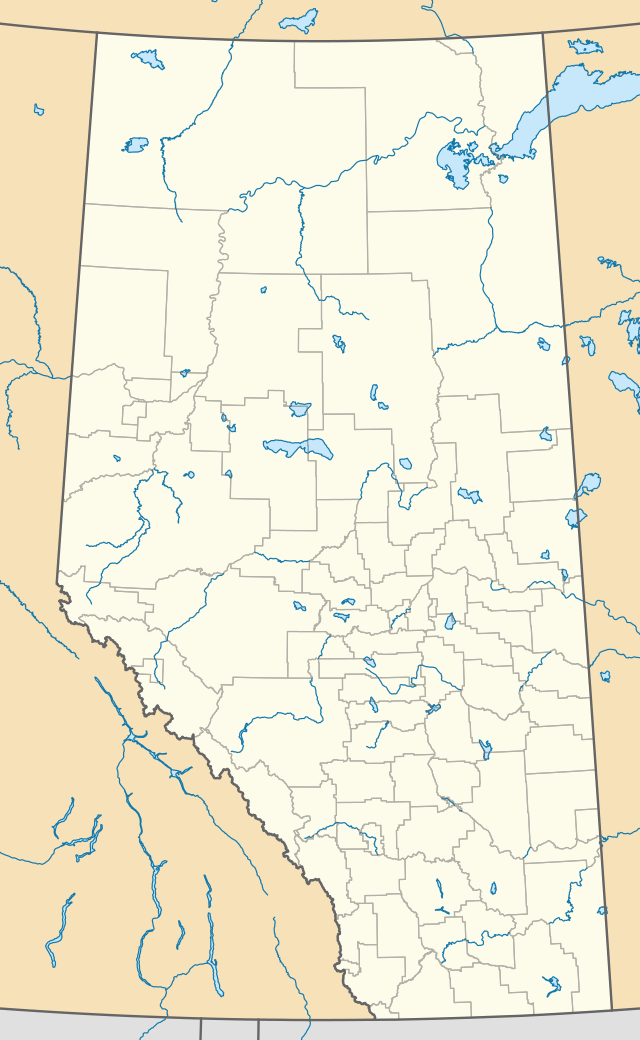Coalspur Formation
The Coalspur Formation is an Upper Cretaceous to lower Palaeocene stratigraphic unit of the Western Canada Sedimentary Basin in the foothills of southwestern Alberta.[2] Its deposition spanned the time interval from latest Cretaceous (Maastrichtian) to early Palaeocene, and it includes sediments that were deposited before, during, and after the Cretaceous-Paleogene (K-Pg) extinction event. It includes the economically important coal deposits of the Coalspur Coal Zone, as well as nonmarine plant and animal fossils.
| Coalspur Formation Stratigraphic range: Maastrichtian to Danian | |
|---|---|
| Type | Formation |
| Unit of | Saunders Group |
| Sub-units | Coalspur coal zone, Entrance conglomerate |
| Underlies | Paskapoo Formation |
| Overlies | Brazeau Formation |
| Thickness | Up to about 550 metres (1,800 ft) |
| Lithology | |
| Primary | Sandstone, siltstone, shale |
| Other | Coal, conglomerate, bentonite |
| Location | |
| Coordinates | 53.0°N 116.8°W |
| Approximate paleocoordinates | 60.6°N 91.6°W |
| Region | |
| Country | |
| Extent | Western Canada Sedimentary Basin |
| Type section | |
| Named for | Coalspur, Alberta |
| Named by | B.R. MacKay[1] |
| Year defined | 1949 |
 Coalspur Formation (Canada)  Coalspur Formation (Alberta) | |
Lithology
The sediments of the Coalspur Formation were eroded from the Canadian Cordillera, and were transported eastward by river systems and deposited in fluvial channel and floodplain environments.[2] The formation consists primarily of sandstones and siltstones, interbedded with mudstones and minor amounts of bentonite. Thick coal seams are present locally in the upper portion of the formation, especially in the Alberta Coal Branch area southeast of Hinton, Alberta. Near the Athabasca River the base consists primarily of conglomerate and is known as the Entrance Conglomerate.[3]
Stratigraphy and age
The Coalspur Formation is part of the Saunders group. The K-Pg boundary has been identified within the formation at the base of the lowermost coal seam (the Mynheer seam), based on changes in the fossil pollen assemblage and the presence of an iridium anomaly.[4] The boundary subdivides the Coalspur Formation into an upper member called the Coalspur coal zone which is of early Paleocene age, and an unnamed lower member of latest Cretaceous age.[3]
Thickness and distribution
The Coalspur Formation is present in the Alberta foothills from south of the Wapiti River to the North Saskatchewan River.[5] The formation is estimated to reach thicknesses of up to about 550 metres (1,800 ft), and the Coalspur coal zone is about 120 metres (390 ft) to 200 metres (660 ft) thick.[3]
Relationship to other units
The Coalspur Formation rests abruptly on the Brazeau Formation and is overlain abruptly by the Paskapoo Formation. It is equivalent to the Scollard Formation of the west-central Alberta plains, the Willow Creek Formation in the southwestern plains, and part or all of the Ravenscrag Formation in Saskatchewan.[3][6] The base of the Coalspur coal zone is equivalent to the base of the Ardley coal zone, which is also floored on the K-Pg boundary bed.[4][7]
Paleontology
Plant fossils[8] and mammal remains[9] have been described from the Coalspur Formation, but although the lower part of the formation is of Late Cretaceous age, no dinosaur remains have yet been reported.
Fossils reported from the Coalspur Formation:[10]
- Mammals
- Neoplagiaulax cf. nanophus
- N. cf. nelsoni
- Simpsonictis cf. jaynanneae
- Aphronorus sp.
- Baiotomeus sp.
- Colpoclaenus sp.
- Mimetodon sp.
- Pararyctes sp.
- Parectypodus sp.
- Promioclaenus sp.
- Propalaeosinopa sp.
- Ptilodus sp.
- Condylarthra indet.
- Lipotyphla indet.
- Neoplagiaulacidae indet.
- Paromomyidae indet.
- Creodonta indet.
Resources
The Coalspur Formation includes seven major seams that range up to 22 metres (72 ft) in thickness. The coal is of sub-bituminous B to C rank, with a low sulphur content. It is mined in the Alberta Coal Branch area and shipped to electric power generating stations in Canada and abroad.[11]
References
- Mackay, B.R. 1949. Coal areas of Alberta. Geological Survey of Canada, Atlas to accompany estimate of coal reserves for the Royal Commission on Coal.
- Mossop, G.D. and Shetsen, I. (compilers), Canadian Society of Petroleum Geologists (1994). "The Geological Atlas of the Western Canada Sedimentary Basin, Chapter 24: Upper Cretaceous and Tertiary strata of the Western Canada Sedimentary Basin". Archived from the original on 2016-07-01. Retrieved 2016-06-20.CS1 maint: multiple names: authors list (link)
- Glass, D.J. (editor) 1997. Lexicon of Canadian Stratigraphy, vol. 4, Western Canada including eastern British Columbia, Alberta, Saskatchewan and southern Manitoba. Canadian Society of Petroleum Geologists, Calgary, 1423 p. on CD-ROM. ISBN 0-920230-23-7.
- Jerzykiewicz, T. and Sweet, A.R. 1986. The Cretaceous-Tertiary boundary, central Alberta foothills. In: Stratigraphy. Canadian Journal of Earth Sciences, vol. 23, p. 1356-1374.
- Prior, G. J.; Hathaway, B.; Glombick, P.M.; Pana, D.I.; Banks, C.J.; Hay, D.C.; Schneider, C.L.; Grobe, M.; Elgr, R. & Weiss, J.A. (2013). "Bedrock Geology of Alberta. Alberta Geological Survey, Map 600". Archived from the original on 2016-06-26. Retrieved 2016-06-20.
- Alberta Geological Survey, 2013. "Alberta Table of Formations; Alberta Energy Regulator" (PDF). Archived from the original (PDF) on 2015-09-25. Retrieved 2016-06-20.
- Langenberg, C.W., Berhane, H., Sweet, A.R., Marchioni, D. and Heamann, L.M. 2007. Regional correlations of the Ardley coal zone, Alberta. Alberta Geological Survey, Earth Sciences Report 2007-5, 21 p.
- Bell, W.A. 1949. Uppermost Cretaceous and Paleocene floras of western Canada. Geological Survey of Canada, Bulletin 13, 231 p.
- Fox, R.C., 1990. The succession of Paleocene mammals in western Canada. Geological Society of America, Special Paper 243, pp. 51-70.
- Diss Locality at Fossilworks.org
- Mossop, G.D. and Shetsen, I. (compilers), Canadian Society of Petroleum Geologists (1994). "The Geological Atlas of the Western Canada Sedimentary Basin, Chapter 33: Coal Resources of the Western Canada Sedimentary Basin". Archived from the original on 2016-07-01. Retrieved 2016-06-20.CS1 maint: multiple names: authors list (link)
External links
- Various Contributors to the Paleobiology Database. "Fossilworks: Gateway to the Paleobiology Database". Archived from the original on 31 July 2014. Retrieved 8 July 2014.